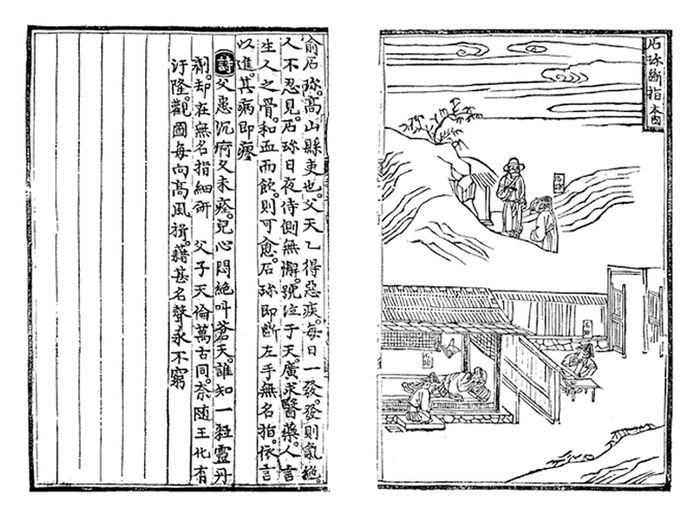(Translation) 石珍斷指
| Primary Source | ||
|---|---|---|
 |
Title | |
| English | ||
| Chinese | ||
| Korean(RR) | ||
| Text Details | ||
| Genre | ||
| Type | ||
| Author(s) | ||
| Year | ||
| Source | ||
| Key Concepts | ||
| Translation Info | ||
| Translator(s) | Participants of 2018 Summer Hanmun Workshop (Intermediate Training Group) | |
| Editor(s) | ||
| Year | 2018 | |
Original Script
【詩】父患沈痾久未痊. 兒心悶絶呌蒼天.
誰知一粒靈丹劑. 却在無名指細硏.
父子天倫萬古同. 奈隨王化有汙隆.
觀圖每向高風揖. 藉甚名聲永不窮.
Translation
Student : Kathy Lin
There was a man named Yu Shi Zhen, an official from the county of Gao Shan. His father was very ill, and every day had an episode from which he would faint. It was truly difficult to witness. All day and night Shi Zhen ceaselessly attended to his father and stayed by his side. He cried to the heavens imploring for a healer, for a cure. People said that the bone of a living person taken together with blood could cure the illness. So Shi Zhen cut off the fourth finger of his left hand and, according to the prescription, gave it to his father. His father recovered from the illness.
Verse:
A father had long been ill. The son, distressed, cried to the blue heavens.
Who knew: a pellet of powerful medicine in a finely ground fourth finger.
The way of father and son remains the same as the myriad times of old. How could this change, according to the changes of kings?
Look, this picture: all respect the high customs. A great name will never be forgotten.
- Discussion Questions:
+ When a place name has a meaning, like 高山, would it be better to translate it in phonetic transliteration, or meaning, like "High Mountain"? I'm inclined toward the former so as not to "exoticize" a place name but I'm not sure. Also, I'm transliterating into Mandarin Chinese phonetics but realize that if I were translating a Korean text, I'd better transliterate into Korean phonetics.
(JG) I agree that transliteration is better, especially for shorter passages.I guess if it were a novel and the names of characters or places had special meaning, one might need to reconsider or add extensive footnotes. As for the phonetics, I usually do go for Korean when the source is Korean, like here.
+ 天乙in the third clause - how to translate this? I don't recall from class.
(Fran): I can't remember what 天乙 means either! I have the line 奈隨王化有汙隆 as meaning "How can following kingly transformation have ups and downs?" with 汙隆 meaning befoulment and prosperity, respectively, and this seems to better follow the sense of the previous phrase about the way of father and son remaining constant through the ages. But I would like to know more about this phrase, "kingly transformation." Finally, you translate 觀圖 as an imperative ("Look, this picture"), but I wonder if it can be descriptive: "Looking at the picture, everyone follows the high customs." This seems to refer to the function and efficacy of the Samgang Haengsil-to itself as a text and image.
(JG) It's the name of the father, I have it as Cheoneul, but someone who know Korean might be more helpful :)
(YO) The Korean names 兪石珍 and 天乙 are romanized Yu Sŏkchin and Ch'ŏnŭl (in McCune-Reischauer system) or Yu Seokjin and Cheoneul (in MOE system). 高山 is Kosan (M-R) or Gosan (MOE). Place names are generally phonetically transcribed and you can add the literal meaning in square bracket (e.g., Kosan 高山 [High Mountain]) if needed.
(YO) As for Fran's questions: 奈隨王化有汙隆 literally means "How would it be (奈) that there be befouling and prosperity (有汙隆) following/according to (隨) kingly transformation (王化)?" Filial actions such as Sŏkchin's is ever-existing and everlasting and do not fluctuate according to king's (or government's) moral edification.
I agree with translating 觀圖 as a descriptive statement ("looking at the picture, ...").